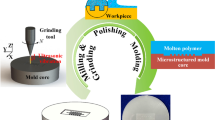Abstract
We report an initial study on hot roller embossing as a potential process for the mass production of polymer based microfluidic chips. Measurements conducted on 100 µm features showed that the lateral dimensions could be replicated to within 2% tolerance, while over 85% of mould depth was embossed. Feature sizes down to 50 µm and feature depths up to 30 µm had been achieved. Results revealed that the embossing depth increased with an increase in the nip force or a decrease in the rolling speed. There was an optimum temperature for achieving a high embossing depth; this was due to the reflow effect seen at higher temperatures. One observation included an asymmetric pile up of polymer material outside the embossed regions as a result of the orientation of the microchannel with respect to the rolling direction. This directional effect could be due to the dynamics of the roller setup configuration.












Similar content being viewed by others
References
Gale MT, Gimkiewicz C, Obi S, Schnieper M, Sochtig J, Thiele H, Westenhofer S (2005) Replication technology for optical microsystems. Opt Lasers Eng 43:373–386. doi:10.1016/j.optlaseng.2004.02.007
Herzig HP (1997) Micro-optics: elements, systems and applications. Taylor & Francis, London
Ng SH, Wang ZF, Tjeung RT, de Rooij NF (2007) Development of a multi-layer microelectrofluidic platform. J Microsyst Microsyst 13:1509–1515. doi:10.1007/s00542-006-0341-6
Schift H, Halbeisen M, Schutz U, Delahoche B, Vogelsang K, Gobrecht J (2006) Surface structuring of textile fibers using roll embossing. Microelectronic Eng 83:855–858. doi:10.1016/j.mee.2006.01.120
Tan H, Gilbertson A, Chou SY (1998) Roller nanoimprint lithography. J Vac Sci Technol B 16:3926–3928. doi:10.1116/1.590438
Acknowledgments
This research is funded by the Agency for Science, Technology and Research (A*STAR), Singapore.
Author information
Authors and Affiliations
Corresponding author
Rights and permissions
About this article
Cite this article
Ng, S.H., Wang, Z.F. Hot roller embossing for microfluidics: process and challenges. Microsyst Technol 15, 1149–1156 (2009). https://doi.org/10.1007/s00542-008-0722-0
Received:
Accepted:
Published:
Issue Date:
DOI: https://doi.org/10.1007/s00542-008-0722-0




